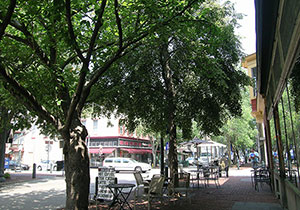Recommended Tree List
Download an Excel Spreadsheet of the Recommended Tree List
The "Full List" tab includes tree species listed in red that are commonly found on municipal tree lists that CCPC does not recommend due to their disease susceptibility, likelihood of poor adaptation to climate change, or lack of commercial availability. Municipalities may wish to compare the species on their existing tree list to this list. The Spreadsheet also includes a full list of recommended trees, as well as lists of recommended street trees, evergreens, and trees for naturalized areas and riparian buffers.
Download a PDF
The PDF includes a full list of recommended trees, urban/street trees, and replacement tree plantings and riparian buffer plantings.
About the Recommended Tree List
This tree list was prepared by the Chester County Planning Commission and was reviewed and validated by experts in the field. Many municipalities' subdivision and land development ordinances contain recommended tree lists, and this list is offered as a resource to municipalities to reference in their ordinances. The list is not intended to guide what landowners should plant on their properties (although it can be a helpful resource), but rather to guide large-scale tree plantings that occur as part of new developments. The list will be kept up to date as conditions change and more is known about the durability and availability of these species. If you have any comments or suggestions related to the tree list, please send them to sustainability@chesco.org.

Choosing appropriate trees for new developments is a decision that will have long-term impacts for the development's quality of place and its ability to manage stormwater, protect soils from eroding, provide shade, and confer ecological benefits. The trees on this list meet the following criteria:
- Native to the eastern United States*
- Limited susceptibility to serious disease and/or pests
- Expected to tolerate environmental changes resulting from a changing climate**
- Generally commercially available at wholesale nurseries
*Because so few evergreen species native to the eastern United States are expected to thrive in warming climatic conditions, several non-native, non-invasive species are included in this list. Evergreen trees often serve important buffering functions in land developments, and providing trees that will thrive in the long term is important to maintaining buffer conditions. Municipalities may want to consider requiring native tree species comprise a certain percentage of evergreen buffer plantings.
** Climate resilience information was derived from two sources:
- PA DCNR's 2018 Climate Change Adaptation and Mitigation Plan — This Plan provides projections for how the habitat distribution could change for key tree species in the commonwealth. It also includes projections of hardiness and heat zones, which can be used to determine if an area will be suitable for planting.
- The USDA Forest Service's Climate Change Tree Atlas for PA — This data models the potential for change in suitable habitat for 125 tree species under two different emissions scenarios- the moderate RCP 4.5 scenario, and the higher RCP 8.5 scenario. The Recommended Tree List reflects the projection identified in the moderate emissions scenario (RCP 4.5).
If there were discrepancies between these two sources in the projections for a given species, the Recommended Tree List reflects the range in projections.
For additional information on tree selection in a changing climate, visit the following websites:
- USDA Forest Service — Climate Tree Atlas
- Brandywine Conservancy — Trees to Plant in a Changing Climate
- DCNR — Climate Resilient Tree list
- WeConserve PA — Stewardship Handbook
Young trees can also be susceptible to damage from deer. Although no tree species is entirely safe from deer browse, some trees are less desirable to deer. Penn State Extension maintains a list of deer-resistant species.

